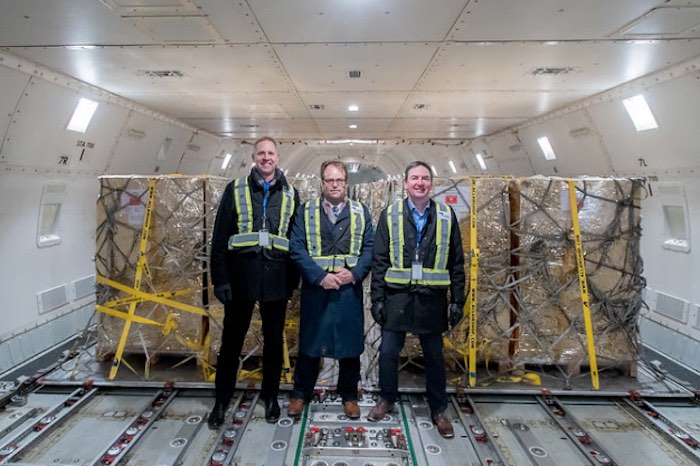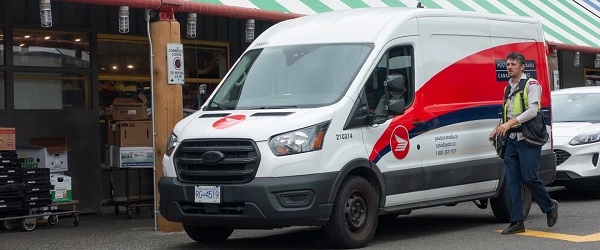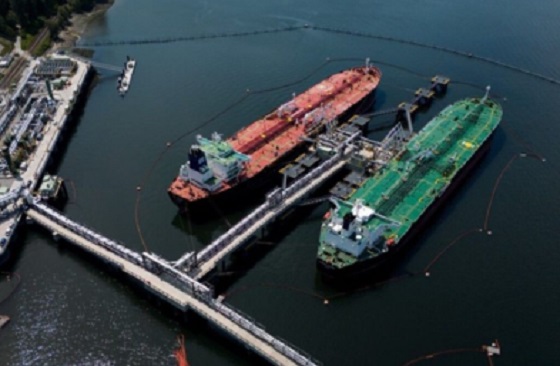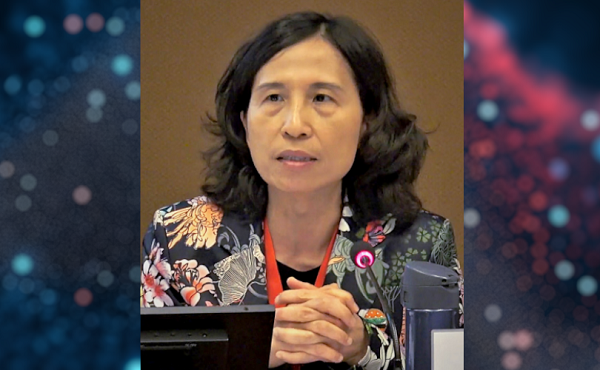Alberta
First shipment of children’s medication arrives

Deputy Premier Nathan Neudorf, Myron Keehn, CEO of Edmonton International Airport and Minister of Health Jason Copping meet the flight carrying the first shipment of children’s pain medication at the Edmonton International Airport.
Alberta’s first shipment of children’s liquid acetaminophen has arrived and will be distributed to hospitals across the province immediately.
This shipment of 250,000 bottles will bolster supply to hospitals in the province, making sure access to medication is not delayed and children who are being treated on site can get the pain and fever relief they need.
“This is a great first step and I am so pleased that we have been able to secure additional children’s medicine for our hospitals. But we cannot and will not rest with this first shipment. We need approval of the rest of the medication so parents can use them at home. We’re in the midst of an exceptionally difficult winter, made more stressful for parents by the shortage of basic medications. Kids and families are waiting for these medications and we need Health Canada to approve them without further delay.”
“I’d like to thank our dedicated health professionals for providing the very best of care to our children during these challenging times. This much-needed supply will help Alberta’s hospitals manage pain and fevers for children across the province.”
In order to receive Health Canada approval, the manufacturer was required to submit a proposal outlining information on the medicine’s quality, safety and product packaging. Health Canada reviewed the proposal and requested additional information as well as a number of changes to meet Canada’s regulatory requirements. One of these changes was the need to add child-resistant caps to the bottles for the retail use supply.
In the interim, an initial shipment was approved for hospital use only, as child-resistant caps are not a regulatory requirement when medicine is administered by medical professionals in a hospital. As a result, rather than wait for the total shipment, Alberta’s government opted to receive a first shipment with medicines for hospital use.
“AHS is grateful for this supply, which provides assurance, long-term, for our stock of acetaminophen in AHS facilities. As drug shortages continue to occur globally, substantial supply of routine medicines is a proactive step that will help our ability to deliver care. We are grateful to all the teams that have helped secure this additional medication.”
The final requirement for child-proof caps has been addressed and the manufacturer has provided all information requested by Health Canada. Alberta’s government is now awaiting Health Canada’s approval of the remaining 4.75 million bottles for retail sale across the province, as are Alberta parents and guardians.
Once received, the medications will be provided to pharmacies for sale at prices in line with the usual retail price. The government is paying a small premium over the expected retail price to secure these medications at a time when there have been global shortages. The full cost will be released when the medication is approved by Health Canada.
Alberta
Alberta uncorks new rules for liquor and cannabis

Alberta’s government is supporting liquor producers by enabling them to own, operate and sell their own products on large format bikes or “party bikes.”
Albertans out for a spin on a party bike or tavern tour will soon be able to sip locally made beers and spirits. Alberta’s government is updating the rules to give small liquor producers the green light to serve their own products on party bikes, removing an outdated barrier that had prevented local producers from advertising their own brands.
This is one of several red tape reduction changes to the Gaming, Liquor and Cannabis Regulation (GLCR) aimed at making life easier for small businesses and expanding responsible choices for consumers.
“We are proud that these amendments not only cut red tape in the retail segment of the liquor marketplace, but also directly open more opportunities for small manufacturers to grow their businesses.”
More freedom to grow: Liquor and cannabis reforms
In addition to the changes to party bikes, Alberta is making it easier for liquor retailers to set up shop in underused commercial space. Businesses that own or lease large buildings can now carve out a separate liquor store within their space, so long as it has its own entrance and full floor-to-ceiling walls separating it from other retail operations.
Alberta’s government is also rolling out a long-awaited change for cannabis producers: federally licensed cultivators and processors will now be able to apply for a retail licence to sell their products directly from the same property, commonly known as “farm-gate” sales. This move aligns Alberta with other provinces and gives consumers more access to homegrown cannabis products, while supporting licensed growers.
These targeted reforms are part of Alberta’s broader push to cut red tape, reduce regulatory burden, and promote a more competitive marketplace across the province.
Quick facts
- Alberta’s retail liquor industry is robust, with more than 35,000 products available across more than 1,600 retail stores
- Larger companies with other retail stores, operate multiple retail stores that have a liquor store on site, but in a separate building.
- There are 752 licenced cannabis retail stores in Alberta.
- There are 2,356 licensed cannabis products for sale in the province.
- All cannabis retailers must be licensed by AGLC.
- Licensed producers are regulated by Health Canada.
Alberta
Alberta government records $8.3 billion surplus—but the good times may soon end

From the Fraser Institute
By Tegan Hill
According to last week’s fiscal update, the Smith government recorded a $8.3 billion surplus in 2024/25—$8 billion more than what the government projected in its original 2024 budget. But the good times won’t last forever.
Due largely to population growth, personal income tax revenue exceeded budget projections by $500 million. Business tax revenue exceeded budget expectations by $1.1 billion. And critically, thanks to relatively strong oil prices, resource revenue (e.g. oil and gas royalties) saw a $4.7 billion jump.
The large budget surplus is good news, particularly as it will be used to pay down government debt (which taxpayers must ultimately finance) and to invest for the future. But again, the good times could soon be over.
Recall, the Alberta government incurred a $17.0 billion budget deficit just a few years ago in 2020/21. And it wasn’t only due to COVID—until the recent string of surpluses, the government ran deficits almost every year since 2008/09, racking up significant amounts of debt, which still largely persists today. As a result, provincial government debt interest payments cost each Albertan $658 in 2024/25. Moreover, in February’s budget, the Smith government projected more deficits over the next three years.
Generally, Alberta’s fiscal fortunes follow the price of oil. Over the past decade, for example, resource revenue has been as low as $2.8 billion in 2015/16, while oil prices slumped to $US45.00 per barrel, and as high as $25.2 billion in 2022/23, when oil prices jumped to $US89.69 per barrel.
Put simply, resource revenue volatility fuels Alberta’s boom-and-bust cycle. In 2025/26, the West Texas Intermediate oil price will be a projected $US68.00 per barrel with projected resource revenue falling by $4.9 billion year-over-year.
But oil prices don’t need to dictate Alberta’s fiscal fortune. Indeed, if the Smith government restrains its spending, it can avoid deficits even when resource revenues fall.
There are plenty of ways to rein in spending. For instance, the government spends billions of dollars in subsidies (a.k.a. corporate welfare) to select industries and businesses in Alberta every year despite a significant body of research that shows these subsidies fail to generate widespread economic benefit. Eliminating these subsidies is a clear first step to deliver significant savings.
The budget surplus is undoubtedly positive for Albertans, but the good times could soon come to an end. To avoid deficits and debt accumulation moving forward, the Smith government should rein in spending.
-

 Business2 days ago
Business2 days agoLatest shakedown attempt by Canada Post underscores need for privatization
-

 Business2 days ago
Business2 days agoWhy it’s time to repeal the oil tanker ban on B.C.’s north coast
-

 Alberta2 days ago
Alberta2 days agoPierre Poilievre – Per Capita, Hardisty, Alberta Is the Most Important Little Town In Canada
-

 Energy2 days ago
Energy2 days agoIf Canada Wants to be the World’s Energy Partner, We Need to Act Like It
-

 MxM News2 days ago
MxM News2 days agoUPenn strips Lia Thomas of women’s swimming titles after Title IX investigation
-

 Alberta2 days ago
Alberta2 days agoAlberta Provincial Police – New chief of Independent Agency Police Service
-

 COVID-191 day ago
COVID-191 day agoTop COVID doctor given one of Canada’s highest honors
-

 Crime2 days ago
Crime2 days agoBryan Kohberger avoids death penalty in brutal killing of four Idaho students







